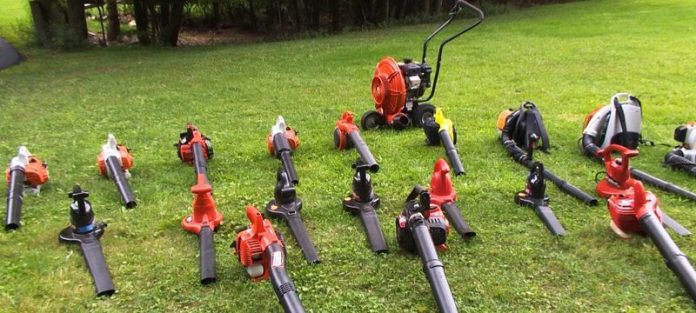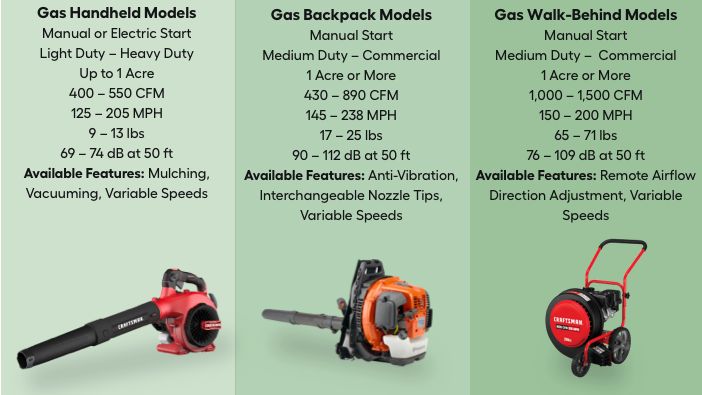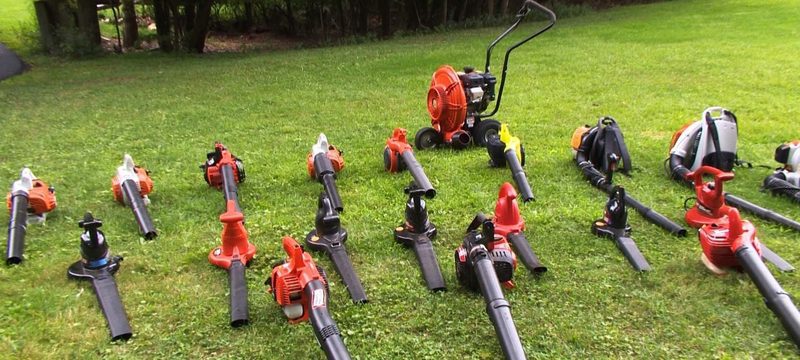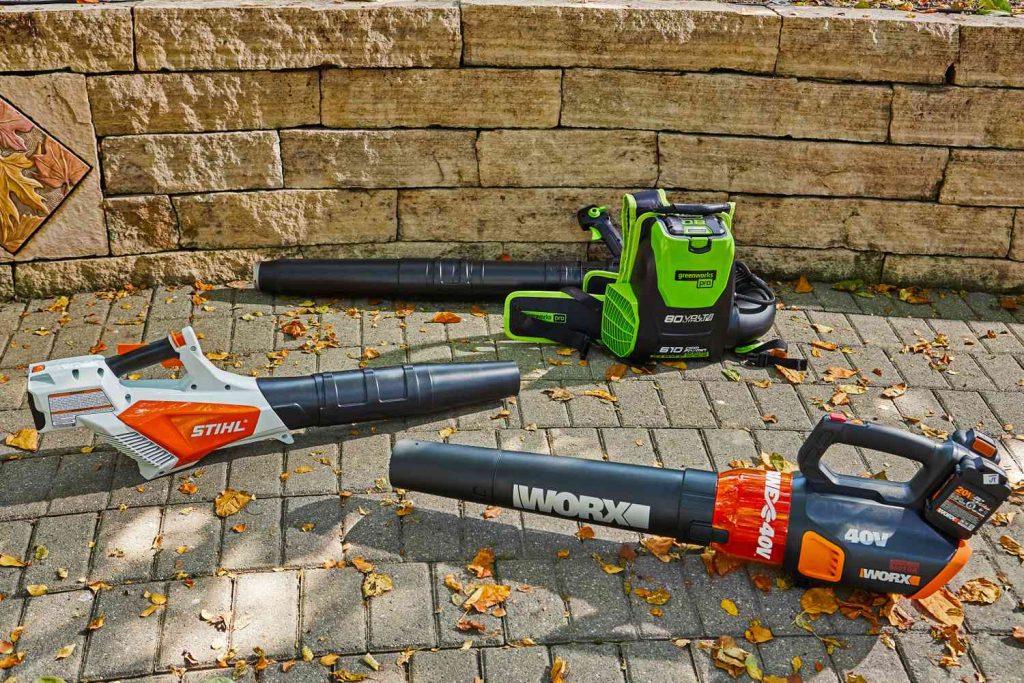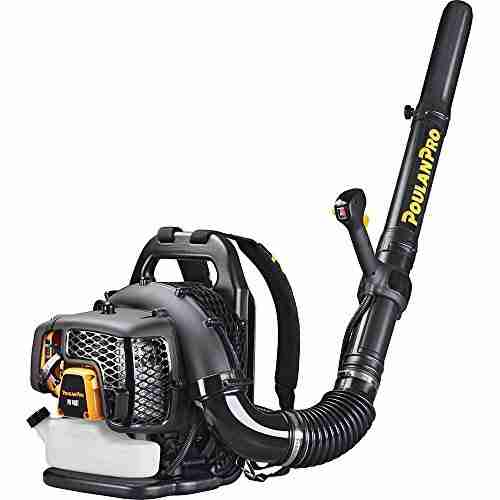Good day! Today, we’re here to discuss an essential tool for maintaining a tidy yard – leaf blowers! From clearing fallen leaves to eliminating debris, leaf blowers come in various types, each with unique features and benefits.
You’re in the right place if you’ve ever wondered about the different types of leaf blowers available. Join us as we explore the diverse world of leaf blowers and discover which type might suit your needs best.
This image is the property of mobileimages.lowes.com.
Corded Leaf Blowers
Corded leaf blowers are popular among homeowners due to their affordability and ease of use. These leaf blowers are powered by electricity and come with a power cord that needs to be connected to an electrical outlet.
Features
One of the critical features of corded leaf blowers is their constant power source. Since they are connected to an electrical outlet, you don’t have to worry about the battery running out or refueling with fuel like gas-powered blowers. Corded blowers are also typically weightier than gas-powered blowers, making them easy to maneuver and carry around the yard.
Pros
One of the most significant advantages of corded leaf blowers is their lower price point than other types. They are more affordable, making them suitable for homeowners on a budget. Corded blowers also tend to be quieter than gas-powered blowers, making them ideal for use in residential neighborhoods where noise restrictions may apply. Additionally, since they don’t require fuel or batteries, there is little to no maintenance required for corded leaf blowers.
Cons
The main disadvantage of corded leaf blowers is their limited range. Since they are connected to a power outlet, the length of the power cord restricts how far you can go with the blower. This can be inconvenient if you have a large yard or need to reach areas far from the outlet.
Another drawback is the potential tripping hazard posed by the power cord. You must be mindful and ensure the cord is out of the way to avoid accidents. Additionally, the blower’s power may be limited compared to gas-powered blowers, affecting its efficiency in handling heavier debris.
Cordless Leaf Blowers
Cordless leaf blowers offer more freedom of movement than corded blowers, as they do not have a power cord restricting their range. These blowers are powered by rechargeable batteries, providing a portable and convenient option for keeping your yard clean.
Features
The main feature of cordless leaf blowers is their battery-powered operation. With a fully charged battery, you can take the blower anywhere in your yard without the hassle of a power cord. Most cordless blowers have a removable battery, allowing a spare battery for extended run-time. They are typically lightweight and easy to maneuver, making them suitable for people of all ages and physical abilities.
Pros
Cordless blowers offer excellent portability and freedom of movement. Without a power cord, you can easily navigate obstacles and reach areas that might be difficult with a corded blower. They are also quieter than gas-powered blowers, reducing noise pollution in your neighborhood. Another advantage is the minimal maintenance required, as you don’t need to deal with fuel or oil changes.
Cons
The main drawback of cordless leaf blowers is their limited battery life. Depending on the model, battery run-time can vary, and you may need to stop and recharge the battery multiple times during an extensive cleanup. This can be time-consuming and may hinder progress if you have a lot of leaves to clear.
Another downside is the initial cost of purchasing a cordless blower, as they tend to be more expensive than corded blowers due to their battery-powered operation. Additionally, the blower’s power may not match that of gas-powered blowers, which could affect its performance when dealing with heavier debris.
Gas-powered Leaf Blowers
Gas-powered leaf blowers are known for their exceptional power and are commonly used for larger areas or heavy-duty tasks. These blowers are fueled by gasoline and offer a high level of performance.
Features
The critical feature of gas-powered leaf blowers is their high-powered engine. They typically come with a two-stroke or four-stroke engine, providing superior blowing force for tackling large piles of leaves and debris. Gas blowers often come with variable speed controls, allowing you to adjust the airflow according to the task. They are also designed with sturdy construction, making them durable and capable of withstanding demanding use.
Pros
One significant advantage of gas-powered leaf blowers is their unmatched power. They can easily handle large yards, heavy leaves, and even wet debris, which might be more challenging for other blowers. Gas blowers also offer longer run times than battery-powered blowers, allowing you to work for extended periods without stopping and recharging. Additionally, they provide greater mobility and range than corded blowers since they do not rely on an electrical outlet.
Cons
One of the significant drawbacks of gas-powered leaf blowers is their noise level. They tend to be louder than other types of blowers, which can disrupt the user and the surrounding environment. Gas blowers also require regular maintenance, including fueling, cleaning, and oil changes, which adds to their overall cost and effort. Another potential disadvantage is the emission of fumes, which can concern those with respiratory issues or in areas with strict air quality regulations.
Backpack Leaf Blowers
Backpack leaf blowers are designed for those who require a more comfortable and ergonomic option for extended use. These blowers are worn on the back, reducing arm strain and providing better weight distribution.
Features
One of the main features of backpack leaf blowers is their ergonomic design. They come with padded and adjustable shoulder straps, allowing you to distribute the weight evenly across your back. This makes them more comfortable for extended periods, reducing arm fatigue and strain. Backpack blowers also typically have a larger fuel tank capacity than handheld blowers, providing longer run times and reducing the need for frequent refueling.
Pros
The primary advantage of backpack leaf blowers is their comfort and ease of use. The ergonomic design and weight distribution make them more user-friendly for extended work periods, resulting in less fatigue and discomfort. They are also powerful, offering high blowing speeds and improved efficiency in clearing more significant areas. Additionally, backpack blowers often come with features such as throttle controls, vibration-dampening systems, and noise-reducing technology, enhancing the overall user experience.
Cons
One potential downside of backpack leaf blowers is their higher cost than handheld blowers. The added features and comfort come at a price, making them a less affordable option for some homeowners. They are also bulkier and heavier than handheld blowers, which may concern those who prefer lightweight and compact tools. Another consideration is the noise level, as backpack blowers can still be relatively loud despite noise-reduction features.
This image is the property of www.rcpw.com.
Handheld Leaf Blowers
Handheld leaf blowers are the most common and widely used leaf blowers. They are suitable for homeowners with smaller yards or lighter cleaning tasks.
Features
The main feature of handheld leaf blowers is their compact and lightweight design. They are easy to carry and maneuver, making them suitable for users of all ages and physical abilities. Handheld blowers often come with variable speed settings, allowing you to adjust the power according to the task. They are also typically more affordable compared to backpack or gas-powered blowers.
Pros
The primary advantage of handheld leaf blowers is their convenience and ease of use. They are lightweight and portable, allowing you to move around your car quickly. Handheld blowers are also more budget-friendly than other types, making them an accessible option for homeowners who only need to use a blower occasionally. Another advantage is their low maintenance requirements, as they do not rely on gas or show any batteries to charge.
Cons
One of the limitations of handheld leaf blowers is their power output. They may struggle with heavy or wet leaves while they are suitable for smaller yards and lighter debris. They also have a shorter run time than cordless blowers, as they typically rely on a fuel tank that needs refueling. Handheld blowers can be louder than other types depending on the model, which may concern those looking for quieter options.
Walk-Behind Leaf Blowers
Walk-behind leaf blowers are ideal for more significant properties or professional use, where a powerful and efficient leaf blower is necessary.
Features
The critical feature of walk-behind leaf blowers is their self-propelled design. They come with wheels and a handle, allowing you to walk behind the blower while it blows leaves and debris. Walk-behind blowers are typically powered by a gas engine, providing the necessary power to handle large piles of leaves. They also come with adjustable height settings, allowing you to customize the blower’s height to match your comfort.
Pros
One of the significant advantages of walk-behind leaf blowers is their power and efficiency. They can clear large areas quickly, making them suitable for commercial or industrial use. Walk-behind blowers are also less physically demanding, as the wheels and self-propelled feature do most of the work. Additionally, they offer excellent control and maneuverability, allowing you to navigate around obstacles and quickly change direction.
Cons
One potential drawback of walk-behind leaf blowers is their size and weight. They are larger and bulkier than handheld or backpack blowers, requiring more storage space and potentially more challenging to transport. Walk-behind blowers are also more expensive than other types due to their high-powered performance and commercial-grade construction. Another consideration is the noise level, which can be louder than handheld or cordless blowers.
This image is the property of cdn.thewirecutter.com.
Push Leaf Blowers
Push leaf blowers are a manual alternative to handheld blowers, offering a more environmentally friendly option for small yards or light-duty tasks.
Features
The main feature of push leaf blowers is their manual operation. They do not require fuel, batteries, or electricity, making them a sustainable choice for eco-conscious users. Push blowers usually have a rotary brush or paddle mechanism that propels the air forward, creating the blowing effect. They are typically compact and lightweight, making them easy to push and maneuver.
Pros
One significant advantage of push leaf blowers is their eco-friendliness. They produce no emissions since they do not rely on fuel or electricity, making them an excellent choice for those concerned about their environmental impact. Push blowers are also quiet since there is no engine or motor noise. They are usually more affordable than other blowers, making them cost-effective for small yards or occasional use.
Cons
The main limitation of push leaf blowers is their power output. They are designed for light-duty tasks and may not be effective in handling heavy or wet debris. Push blowers also require more physical effort than powered blowers, as you must manually push and guide them. Another consideration is the size of the blower’s collection bag, which may not hold as much debris as other types, requiring more frequent emptying.
Wheeled Leaf Blowers
Wheeled leaf blowers are similar to walk-behind blowers but offer greater mobility and flexibility when maneuvering around your yard.
Features
The critical feature of wheeled leaf blowers is their large wheels. These blowers typically come with oversized, air-filled tires that allow them to navigate various terrains easily. Wheeled blowers are self-propelled, meaning they move forward with minimal effort on the user’s part. They also typically have adjustable speed settings, allowing you to customize the blowing power according to the task.
Pros
One significant advantage of wheeled leaf blowers is their excellent maneuverability. The large wheels and self-propelled features make moving around on different surfaces, such as grass or gravel, easy. Wheeled blowers also offer sufficient power to handle large areas and heavy debris, making them suitable for commercial use or large properties. They provide a more comfortable user experience, as the wheels handle most of the weight, reducing strain on the user.
Cons
The main drawback of wheeled leaf blowers is their size. They tend to be larger and bulkier than handheld or backpack blowers, requiring more storage space and potentially more challenging to transport. Wheeled blowers are also more expensive than other types, as they offer the power and efficiency required for heavy-duty tasks. Another consideration is the noise level, as they can produce louder noise compared to handheld or cordless blowers.
This image is the property of blog.acmetools.com.
Electric Leaf Blowers
Electric leaf blowers are an eco-friendly and convenient option for small to medium-sized yards. They are typically available in both corded and cordless options.
Features
The main feature of electric leaf blowers is their reliance on electricity as a power source. Corded electric blowers come with a power cord that needs to be connected to an electrical outlet, while rechargeable batteries power cordless electric blowers. Electric blowers are generally lightweight, compact, and easy to maneuver. They often come with variable speed settings, allowing you to adjust the blowing power accordingly.
Pros
One of the significant advantages of electric leaf blowers is their eco-friendliness. They produce no emissions during operation, making them a clean and sustainable choice for environmentally conscious individuals. Electric blowers are also relatively quiet compared to gas-powered blowers, reducing noise pollution. They are generally easy to use, require less maintenance than gas blowers, and are more affordable than some higher-end options.
Cons
The primary drawback of electric leaf blowers is their limited range compared to gas-powered blowers. Corded electric blowers have a restricted range due to the power cord, while cordless electric blowers have a limited battery life, requiring periodic recharging. This may be inconvenient if you have a larger yard or need to work for extended periods. Additionally, the power output of electric blowers may not match that of gas blowers, affecting their ability to handle heavy debris.
Battery-powered Leaf Blowers
Battery-powered leaf blowers offer the convenience of cordless operation while eliminating the need for cords or fuel. They are popular among homeowners for their portability and ease of use.
Features
The main feature of battery-powered leaf blowers is their reliance on rechargeable batteries. These blowers typically come with removable batteries, allowing a spare battery for extended run-time. Battery-powered blowers are lightweight and easy to maneuver, making them suitable for users of all ages. They often come with variable speed settings and may have additional features like brushless motors for increased efficiency.
Pros
Battery-powered leaf blowers offer excellent portability and freedom of movement without the constraint of a cord. They are lightweight and easy to carry, allowing you to navigate around obstacles and reach difficult areas. These blowers are typically quieter than gas-powered blowers, reducing noise disturbance. They also require minimal maintenance, as there is no need for fuel or oil changes.
Cons
The main limitation of battery-powered leaf blowers is their limited battery life. Depending on the model and battery capacity, run-time can vary, and you may need to stop and recharge the battery multiple times during larger cleanup tasks. This can slow down progress and may be inconvenient if you have a lot of leaves to clear. Battery-powered blowers may also be more expensive than corded electric blowers due to the cost of the batteries. Additionally, their power output may not match that of gas-powered blowers, affecting performance with heavier debris.
In conclusion, various leaf blowers are available, each with its features, pros, and cons. Corded leaf blowers are affordable and require no maintenance, but the power cord limits their range. Cordless leaf blowers offer portability and convenience but have limited battery life. Gas-powered blowers provide exceptional power for heavy-duty tasks but can be noisy and require regular maintenance. Backpack blowers offer comfort and power but come at a higher cost.
Handheld blowers are lightweight and budget-friendly, but their power output may be lower. Walk-behind blowers are suitable for large areas and offer efficiency but are bulkier. Push blowers are eco-friendly and affordable but have limited power. Wheeled blowers provide excellent maneuverability and power but are more prominent and louder.
Electric blowers are eco-friendly and easy to use but have a limited range. Battery-powered blowers combine cordless convenience with variable power but have limited battery life. Consider your specific needs and yard size when choosing the suitable leaf blower.
This image is the property of www.thespruce.com.

